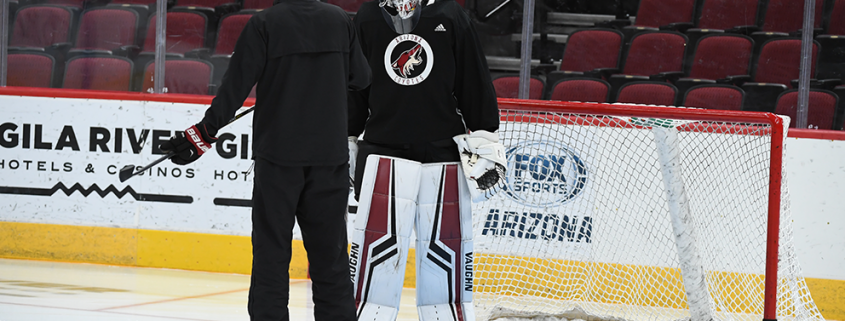Roadrunners Camp Report: Tucson’s Training Camp Trio
The Three Amigos, the Three Musketeers, the Three Stooges.
For Coyotes Goaltending Development Coach Zac Bierk, his favorite group of three at this time, or at least presumably so, is Ivan, Erik and Merrick.
Nickname, pending.
While the norm of most American Hockey League, as well as National Hockey League, is to carry two goaltenders during the regular season, as of Wednesday, Tucson’s Training Camp Roster featured three.
Far from completely unheard of, the situation becomes dynamic when you factor that all three featured are young goaltenders, all out to prove they belong in the Roadrunners crease this season.
No journeymen, no tryouts, just raw, young goaltending.
While it sounds like a good thing, to Bierk, it’s a blessing and a challenge.
“It’s a great situation to be in,” he began with. “We’ve got three good goalies, all hard-working, all talented. Having to figure out where everyone fits is just going to have be something that plays itself out.”
Merrick Madsen, 24, is the most recognized name of Bierk’s current group by Tucson fans, having spent 11 games with the Roadrunners during November and December of last season.
Exploding onto the Southern Arizona netminding scene with consecutive shutouts in his first three starts at Tucson Arena, the Harvard graduate’s season came to an unfortunate end due to an injury, one that required many months of recovery. However, he’s all systems go entering 2019-20.
“Merrick’s 100%,” Bierk confirmed. “He worked really hard this summer, was in good communication with the team, used his resources well that he has with the Coyotes and we’re really happy with how he was able to come back from a pretty severe surgery.”
As Madsen enters his second pro season, Erik Källgren comes to the desert with a set of different hurdles.
A few weeks shy of turning 23, Kallgren vies for Tucson’s net with four seasons of increasing workload in Sweden’s second-highest league of play, Allsvenskan.
Commonly noted with foreign netminders, the largest obstacle is adjusting to the smaller ice. In Källgren’s home country, rinks are usually 13.4 feet wider than most North American rinks, which typically comes hand-in-hand with slower, more passive offensive zone attacks.
“There’s more plays generated from the goal line, from the corner and off cycles than he’s used to,” Bierk mentioned as some of the necessary adjustments that he’s identified for the 6-foot-3, 198-pound goaltender from Stockholm. “Everything comes at the net a little bit quicker over here – it’s usually more of an attacking style.”
Entering the first year of his entry-level contract, which was signed in March, there’s lots of upside and promise for the seventh round selection (#183) of the Arizona Coyotes in 2015.
“He’s watching a lot of film, he came over at the end of last season and get a feel for the American League,” the veteran of seven pro seasons himself complimented of Källgren’s efforts. “He’s a student of the game, so I think he’s doing a good job of trying to implement some strategies and prep for professional hockey over here.”
Albeit a few years removed from his personal adjustments to the North American ice, Ivan Prosvetov was once in the same boat as Källgren.
Hailing from Moscow, the 6-foot-5, 176-pound goaltender works at the Ice Den Scottsdale this week along the aforementioned two, following a camp filled with note and praise with the Arizona Coyotes.
What makes this piece to the puzzle so intriguing is that the cartwheeling (seriously!) enigma is just 20-years-of-age, making him eligible to be playing in the Ontario Hockey League (OHL) once again. With his rights owned by the Saginaw Spirit and OHL regular season already underway, Prosvetov isn’t there and it’s because of the progress he’s made.
“The biggest thing that Ivan can be credited for is implementing some pretty big changes to his game,” Bierk contributed. “When I first saw Ivan last year along with Corey Schwab, the Coyotes Goaltending Coach, it was evident that he has great talent, great size and great compete, but efficiency was something that came naturally to him. Over the course of the season he started to put it together and he was able to have less spectacular saves and more routine saves.”
With just two four-by-six ranges to share right now, Bierk’s viewing the situation in a positive light. “It’s a competition right now,” he said last of the group. “We’re taking it day-by-day and I think the goalies have done a good job of supporting one another, but at the same time, everybody’s competing for a net.”









